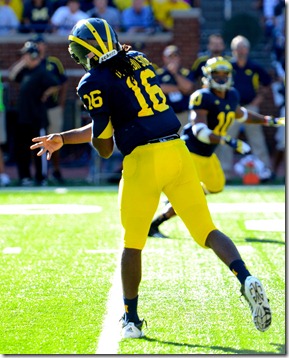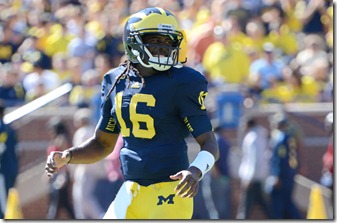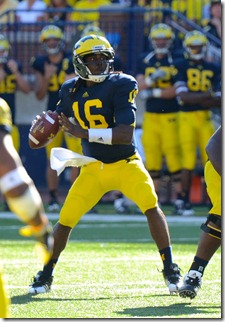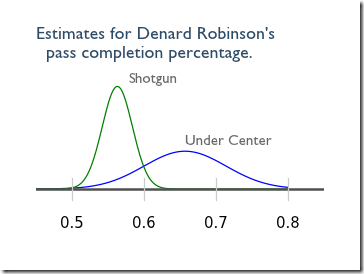Hokepoints: Denard Under Center

There was once a dream that was called Denard Robinson: Accurate Passer. You could only whisper it; anything more than a whisper and it would vanish…it was so fragile. And I fear that it will not survive the fall.
Last Saturday while watching Andrew Maxwell derf another derpity doo, I half-rhetorically asked the assembled a room full of Spartan fans who's the best passing quarterback in our conference this year. Answers, in order of appearance:
- …
- "CHHIIIRP CHIRRRP" –insects with that leg-rubbing noise
- …
- …
- "Howl" –wolf in the distance
- "How about that little dude on Northwestern?" – a Sparty
- "No he graduated." –another Sparty
- …
- "Shit. Really?" –first Sparty
After three weeks the stats (min=25 attempts) say it's Denard and ol' Tyranno-arm:
| Rk | Player | Team | Att | Cmp | Yds | Yds/Att | Ys/Gm | TDs | INTs | Rating |
|---|---|---|---|---|---|---|---|---|---|---|
| 1 | Denard Robinson | Mich | 75 | 41 | 699 | 9.3 | 233.0 | 6 | 4 | 146.3 |
| 2 | Taylor Martinez | Neb | 79 | 56 | 713 | 9.0 | 237.7 | 7 | 1 | 170.7 |
| 3 | MarQueis Gray | Minn | 44 | 26 | 398 | 9.0 | 132.7 | 5 | 169.2 | |
| 4 | Reilly O'Toole | Illini | 48 | 38 | 394 | 8.2 | 131.3 | 6 | 2 | 177.3 |
| 5 | Braxton Miller | OSU | 78 | 48 | 611 | 7.8 | 203.7 | 7 | 2 | 149.1 |
| 6 | Robert Marve | Pur | 56 | 41 | 414 | 7.4 | 207.0 | 4 | 156.7 | |
| 7 | Tre Roberson | Ind | 50 | 33 | 368 | 7.4 | 184.0 | 2 | 139.8 | |
| 8 | Cameron Coffman | Ind | 57 | 40 | 410 | 7.2 | 205.0 | 3 | 146.4 | |
| 9 | Matt McGloin | PSU | 104 | 59 | 688 | 6.6 | 229.3 | 8 | 1 | 133.5 |
| 10 | Danny O'Brien | Wis | 71 | 44 | 454 | 6.4 | 151.3 | 3 | 1 | 125.5 |
| 11 | Trevor Siemian | NW | 47 | 32 | 292 | 6.2 | 97.3 | 1 | 0 | 126.7 |
| 12 | Andrew Maxwell | MSU | 114 | 65 | 710 | 6.2 | 236.7 | 2 | 3 | 109.3 |
| 13 | James Vandenberg | Iowa | 103 | 59 | 593 | 5.8 | 197.7 | 0 | 2 | 101.8 |
| 14 | Kain Colter | NW | 56 | 37 | 321 | 5.7 | 107.0 | 2 | 0 | 124.9 |
| 15 | Caleb TerBush | Pur | 43 | 24 | 237 | 5.5 | 118.5 | 3 | 123.0 |
His interceptions are dragging down the passer rating, but half are explained by an accurate throw Vincent Smith deflected, and Roundtree getting shoved into last Tuesday by a Bama cornerback. It's just three games in, and the Big Ten competition this year isn't exactly the NFC South, but raise your hand if four weeks ago you thought there might be even a flimsy statistical case for saying "Denard is the best passer in the Big Ten right now."
In last week's Mailbag article Brian remarked upon a Mike Rothstein study that claims Denard has been way more accurate under center than from the shotgun. The Power Rank made a chart:
We've been over his higher efficiency as a runner from the gun ad nauseum, and charted his regression last year as of December, but is he really a better passer when dropping back? Brian's suggested explanations were Pressure, Situation, or Luck (ie sample size). Let's dig into the UFR database and see if there's an answer.
[ROLL'D OUT AFTER THE JUMP]
 First, the passing plays charted where Denard was the quarterback:*
First, the passing plays charted where Denard was the quarterback:*
| Formation | 2009 | 2010 | 2011 | 2012 | Total |
|---|---|---|---|---|---|
| Shotgun | 24 | 244 | 218 | 47 | 533 |
| I-Form | 1 | 7 | 36 | 7 | 51 |
| Ace | 1 | 1 | 27 | 3 | 32 |
| Pro | - | - | 3 | - | 3 |
| Goal line | - | - | 2 | - | 2 |
| Fritz | - | - | 1 | - | 1 |
| Total plays | 26 | 252 | 287 | 57 | 622 |
* 2012 is through Air Force. 2011 is missing the bowl game; 2010 is missing Ohio State and the bowl game; 2009 is missing Ohio State.
Right away you can see there's not a lot of under-center throws to go on—only 10 total before last season, and even then less than 1/4 of Denard's passes were not from the shotgun. This year it's 80-20. We're cuttin' out pre-2011 data from here on out. We're also noting marked year-to-year improvement already…
| Charted | 2011 | 2012 (proj) |
|---|---|---|
| Dead-on (DO) | 22 | 5 (25) |
| Catchable+ (CA+) | 26 | 7 (35) |
| Catchable (CA) | 96 | 19 (94) |
| Marginal (MA) | 16 | 5 (25) |
| Inaccurate (IN) | 46 | 7 (35) |
| Tacopants (INX) | 3 | - |
| Bad Read (BR) | 19 | 3 (15) |
| Bad Read X (BRX) | 4 | 1 (5) |
| Other (SCR/TA/BA/PR) | 54 | 9 (45) |
…that actually started after the Iowa game last year and coincides with the shift back to the shotgun. While we're housekeeping, note that Denard threw only once from a goal line set, scrambled out of the only Fritz passing play, and had just three called passes from the Pro-Set—those are charted as I-form, I-form, and Ace, respectively. DSR=downfield success rating, which is catchable and above divided by attempts, with the "Other" stuff (scrambles, throwaways, batted, pressure) not counted. On to the…
ISTHEREACTUALLYADIFFERENCECHART?
Is there actually a difference chart:
| Charted | Shotgun (260 attempts) | I-form (45 attempts) | Ace (33 attempts) | TOTAL (338 attempts) |
|---|---|---|---|---|
| Dead-On (DO) | 7% | 11% | 9% | 8% |
| Catchable (CA or CA+) | 43% | 31% | 67% | 44% |
| Marginal | 7% | 4% | 6% | 6% |
| Inaccurate (IN or INX) | 18% | 16% | 3% | 17% |
| Bad Read (BR or BRX) | 8% | 11% | 3% | 8% |
| Batted (BA) | 2% | 4% | 3% | 3% |
| Pressure (PR) | 8% | 9% | - | 7% |
| Scramble (SCR) | 3% | 11% | 6% | 5% |
| Throwaway (TA) | 3% | 2% | 3% | 3% |
| Yards per play | 8.6 | 8.1 | 11.8 | 8.9 |
| Downfield Success (DSR) | 60.6% | 57.6% | 86.2% | 62.9% |
I bolded a few outliers in there. Before we get to the big thing, notable for both under-center formations is the scrambling goes way up. I sadly don't have data as to whether this is a quirk of shotgun formations but if you close your eyes and imagine a pass rush on a shotgun versus an I-form you can visualize the veracity of this. I would guess this has more to do with defenses familiar with Michigan's shotgun-spread running game being more responsible against the base formation. I don't have proof so I shrug, but I plan to watch more closely in the future to see if defenses are likelier to open up running lanes when Michigan goes to more Manballian offenses.
The big thing: Holy Ace on a bender Batman! that ridiculous downfield success rating from Ace sets is ridiculous. The inaccurate balls and bad reads are way down, and there were no balls thrown to covered receivers because of pressure. Yards per play were way up (in the I-form they're down from average). This was done in just 33 tries (less than 3 per game), but note the I-form attempts are generally in line with with Denard's shotgun efficiency. From here on out we're not talking about under-center, but specifically Ace sets as the formations that turn Denard Robinson into Drew Brees.
Where is this coming from? Rothstein suggests it's nurture:
The comfort comes from Robinson's high school career, when he took snaps under center around 60 percent of the time in a Wing-T offense and would often run a waggle play from which he would pass.
 Waggles is it? We chart waggles. Waggles:
Waggles is it? We chart waggles. Waggles:
| Charted | Waggles (13) | All Plays (338) |
|---|---|---|
| DO | 0% | 8% |
| CA | 46% | 44% |
| MA | 0% | 6% |
| IN | 23% | 17% |
| BR | 8% | 8% |
| SCR | 15% | 5% |
| TA | 8% | 3% |
| DSR | 60.0% | 62.9% |
Not waggles, except there's a lot more scrambling (makes sense). It also makes sense that this knocks down his accuracy since the thing all Denard observers can tell you is he's not all that accurate on the run.
Maybe it's the Pressure Getting to Him?
The idea here is that shotgun passes get more pass rush because that's the formation used when the offense must pass and the defense knows this. Protection metrics for each formation on a per-play basis:
| Formation | Avg. Rush | Avg. Blitzers | Picked Up | Protection Metric |
|---|---|---|---|---|
| Shotgun | 5.40 | 1.67 | 1.29 | 77% |
| I-Form | 5.51 | 1.59 | 1.32 | 83% |
| Ace | 5.53 | 1.80 | 1.67 | 93% |
| Total | 5.42 | 1.67 | 1.31 | 79% |
It looks like the Ace formation faced more rushers total (equivalent to an extra blitzer every 8 or 9 plays or so); it's just that the offensive line has done a far better job of picking up that rush. That may just be on the type of personnel deployed for each (personnel only  shown for pass plays):
shown for pass plays):
| Formation | RBs | TEs | WRs | Run% |
|---|---|---|---|---|
| Shotgun | 1.1 | 0.8 | 3.1 | 67.8% |
| I-Form | 2.0 | 1.4 | 1.7 | 56.5% |
| Ace | 1.1 | 1.7 | 2.2 | 34.7% |
| Total | 1.2 | 0.9 | 2.8 | 56.9% |
So the Ace is where Michigan is deploying two tight ends more often than not, or at least it was last year. It should mean, in general, a pass play from the Ace will have an extra blocker, hence the higher protection metric.
Interestingly, the one thing the Ace doesn't have going for it is the threat of running. While the shotgun makes the defense defend against the bread 'n butter zone reads and Denard runs, and the I-form will faithfully throw Rock 56% of the time, lining up in the Ace formation usually means pass. This is probably why it's getting such a high pass rush.
I've got another theory for why Denard's passing goes up in the Ace, though, and it comes back to what Borges was saying in the presser that Rothstein was quoting: opponents aren't preparing their designer blitzes for Michigan's third-most used formation. The Ace in this offense seems to be performing at an extremely high level because it's a changeup. That goes to situation as well. Here's the formations on distances of 6 or more for called Robinson pass plays:
| Formation | 1st down | 2nd down | 3rd down | 4th down |
|---|---|---|---|---|
| Shotgun | 77 (69%) | 68 (70%) | 74 (97%) | 1 (100%) |
| I-Form | 19 (17%) | 19 (20%) | 2 (3%) | - |
| Ace | 16 (14%) | 10 (10%) | - | - |
The heavy lifting is being done by the shotgun, and when Michigan throws from the Ace it's on 1st or 2nd down. It was deployed just twice in 4th quarters—both times early last year. One was a play-action deep post against San Diego State that Denard put just a bit too far ahead of an open Roundtree; the second was the go-ahead throwback screen to Vincent Smith that always works:
So that's my final answer. Drilling on his footwork seems to be helping Denard's accuracy reach Henne-an efficiency overall, but it's not being under center so much as being in the West Coast offense's dedicated pass-protection formation on 1st and 2nd downs. More time in the pocket means better chances to collect yards with scrambles, and more passes that Robinson has time to step into. For about three plays per game, Borges has found Denard that time by trading in the threat of his quarterback's legs for the built-in passer protections that made the Ace Two-TE formations a favorite among WCO aficionados.
It's not often enough to distract defenses from focusing on stopping the core shotgun spread offense, but it's enough to act as an extra weapon deployed where it can do maximum damage. And from the results above, you'd have to admit this particular course of Borges-Robinson fusion cuisine has been exquisite!
September 18th, 2012 at 12:32 PM ^
September 18th, 2012 at 2:58 PM ^
This is excellent. Nice work. That database is going to have some amazing uses going forward.



Comments